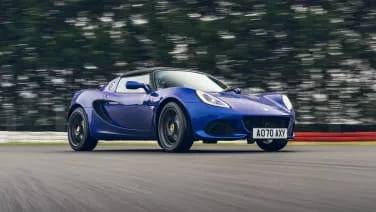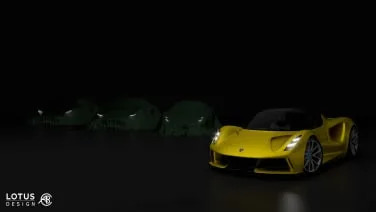2020 Lotus Evora GT
Slipping into the leather, carbon fiber-backed seats and turning on the engine is an event in the 2020 Lotus Evora GT. Stick the stubby, unmarked key in the ignition, turn two notches; press a button on the remote; push the clutch in, and hold the “Engine Start” button down. The tachometer springs to life, zinging up past 2,000 rpm before settling into an even, but emphatic idle. If everybody wasn’t already staring at the little British sports car in the parking lot, they are now. Once the astoundingly complex, but charming start procedure is done, the fun begins. Lotus has sold only one other more powerful version of the Evora in the United States, that being the GT430. This GT is rocking a poked and prodded version of the Toyota 3.5-liter V6 engine found in all Evoras, but as in some other versions, an Edelbrock supercharger has been added to boost output. With the six-speed manual, its output is 416 horsepower and 317 pound-feet of torque. Twist increases to 332 pound-feet with the six-speed automatic, but don’t buy a Lotus with an automatic. Just don’t do it. The gear lever snicks into first with positive, notch-like action. Lotus’ analog gauges stare back, displaying the most important information in a legible size and font. There’s a digital speedometer tucked into a little nook under the steering wheel's red center line, just the right height for a quick glance downward. Grippy leather covers the 9 and 3 positions on the wheel, while soft Alcantara contrasts with the leather on the top and flat bottom of the wheel. Lotus clearly knows that sweaty racetrack hands and Alcantara don’t mix. This clutch is heavy, is the first thought upon setting out on the road. It fits the car and makes the driver work a little to be smooth. Good. Driving a Lotus shouldn’t be a walk in the park. The driving position is bang-on. Those manually-adjustable (and heated!) leather seats are mounted low, their bolsters large enough to be snug, but short enough to slip over getting in. The view forward doesn’t leave much to be desired, but looking out the back is like looking through a mail slot. There’s a tiny box of glass, but it’s tinted, making it difficult to see whatever might be visible. Side mirrors it is, and those are plenty fine, even allowing a view of the wide rear hips. At speed, racecar vibes abound instantly. Lotus uses hydraulic power steering still, imparting all the feel and intimacy lost through most new cars’ electric power steering systems. The exhaust is quiet in the normal Drive mode, but instantly perks up in Sport. This is a car that doesn’t want to crawl around in traffic, but still handles the task adeptly. The air conditioning is strong and easily adjusted by the car’s center controls. Even the aftermarket Alpine head unit has Apple CarPlay and Android Auto. The screen did refuse to turn on a few times, but a quick cycling …
Full Review
Slipping into the leather, carbon fiber-backed seats and turning on the engine is an event in the 2020 Lotus Evora GT. Stick the stubby, unmarked key in the ignition, turn two notches; press a button on the remote; push the clutch in, and hold the “Engine Start” button down. The tachometer springs to life, zinging up past 2,000 rpm before settling into an even, but emphatic idle. If everybody wasn’t already staring at the little British sports car in the parking lot, they are now. Once the astoundingly complex, but charming start procedure is done, the fun begins. Lotus has sold only one other more powerful version of the Evora in the United States, that being the GT430. This GT is rocking a poked and prodded version of the Toyota 3.5-liter V6 engine found in all Evoras, but as in some other versions, an Edelbrock supercharger has been added to boost output. With the six-speed manual, its output is 416 horsepower and 317 pound-feet of torque. Twist increases to 332 pound-feet with the six-speed automatic, but don’t buy a Lotus with an automatic. Just don’t do it. The gear lever snicks into first with positive, notch-like action. Lotus’ analog gauges stare back, displaying the most important information in a legible size and font. There’s a digital speedometer tucked into a little nook under the steering wheel's red center line, just the right height for a quick glance downward. Grippy leather covers the 9 and 3 positions on the wheel, while soft Alcantara contrasts with the leather on the top and flat bottom of the wheel. Lotus clearly knows that sweaty racetrack hands and Alcantara don’t mix. This clutch is heavy, is the first thought upon setting out on the road. It fits the car and makes the driver work a little to be smooth. Good. Driving a Lotus shouldn’t be a walk in the park. The driving position is bang-on. Those manually-adjustable (and heated!) leather seats are mounted low, their bolsters large enough to be snug, but short enough to slip over getting in. The view forward doesn’t leave much to be desired, but looking out the back is like looking through a mail slot. There’s a tiny box of glass, but it’s tinted, making it difficult to see whatever might be visible. Side mirrors it is, and those are plenty fine, even allowing a view of the wide rear hips. At speed, racecar vibes abound instantly. Lotus uses hydraulic power steering still, imparting all the feel and intimacy lost through most new cars’ electric power steering systems. The exhaust is quiet in the normal Drive mode, but instantly perks up in Sport. This is a car that doesn’t want to crawl around in traffic, but still handles the task adeptly. The air conditioning is strong and easily adjusted by the car’s center controls. Even the aftermarket Alpine head unit has Apple CarPlay and Android Auto. The screen did refuse to turn on a few times, but a quick cycling …
Hide Full Review
Hide Full Review
Retail Price
$96,950 - $96,950
MSRP / Window Sticker Price
| Engine | 3.5L V-6 |
| MPG | Up to 17 city / 26 highway |
| Seating | 4 Passengers |
| Transmission | 6-spd man w/OD |
| Power | 416 @ 7000 rpm |
| Drivetrain | rear-wheel |
| Curb Weight | 3,175 lbs |
Smart Buy Program is powered by 





